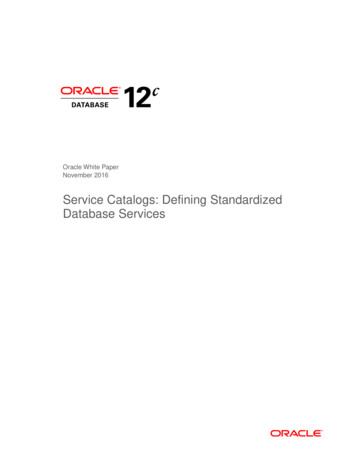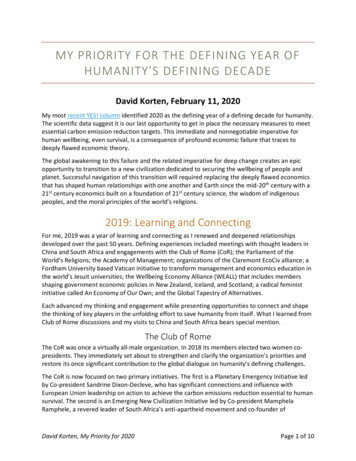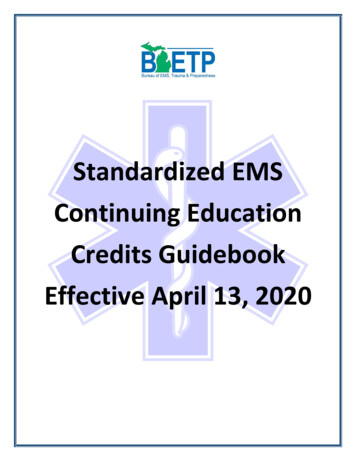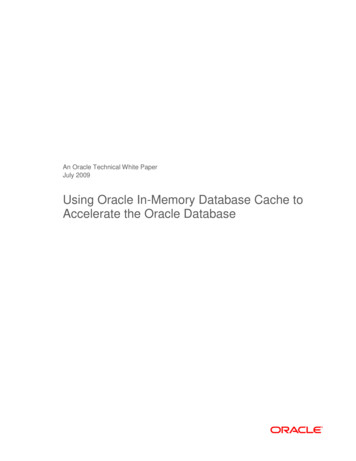
Transcription
Oracle White PaperNovember 2016Service Catalogs: Defining StandardizedDatabase Services
Service Catalogs: Defining Standardized Database ServicesDisclaimerThe following is intended to outline our general product direction. It is intended for information purposesonly, and may not be incorporated into any contract. It is not a commitment to deliver any material, code, orfunctionality, and should not be relied upon in making purchasing decisions. The development, release, andtiming of any features or functionality described for Oracle’s products remains at the sole discretion ofOracle.
Service Catalogs: Defining Standardized Database ServicesService Catalogs enable the evolution to enterprise cloud . 2Service catalog overview . 4Case Studies . 7Standardized service offerings for Oracle Database services . 18Describing availability . 20Oracle Database availability levels . 21Oracle Database security levels . 30Capacity . 33Oracle Database agility levels . 34Oracle Database performance management . 35Consolidating Oracle Database Services. 37Engineered Systems for Oracle Database Services . 38Conclusion . 39Glossary of ‘service’ terms. 40References . 42
Service Catalogs: Defining Standardized Database ServicesService Catalogs enable the evolution to enterprise cloudThe promises of cloud computing—greater agility, less risk, and lower costs—are real, buttheir realization depends on the approach you adopt. Making the full transformation toan enterprise cloud may take several years, and will affect many aspects of organizationsand roles, processes, policies and service delivery. Many enterprises have successfullyorganized their transformation into a phased approach—an evolution to enterprise cloud.Figure 1: Evolution to enterprise cloudThe first step of this transformation is standardization, and one of the key deliverablesthat supports standardization is a service catalog. A service catalog is a collection ofdocuments and artifacts which describe the services an IT organization provides, andspecifies how those services are delivered and managed.Standardized services can be deployed more quickly and repeatably than custom services.This benefits consumers directly since they have faster access to more reliable services,while the provider spends less time with the nuts and bolts of provisioning, and can focuson higher-value initiatives.During its lifecycle, a standardized service will behave predictably during maintenance,unplanned outages, and under system load. Consumers and providers will have common,documented expectations for these scenarios.Moving to a standardized environment is a significant change with important benefits. Ifdone properly, standardization also paves the way for further steps. For example, if mostdeployments use the same operating system and database version, it is easier toconsolidate those deployments together into a shared operating environment.2
Service Catalogs: Defining Standardized Database ServicesThe service delivery phase of the evolution focuses on dynamic, policy-driven resourcemanagement. If the standardized components support those capabilities, then enabling aservice delivery model is a simple matter of activating the supporting features and optionsof the environment – no upgrades or rearchitecting are needed.Effective standardizationThe effectiveness of standardization depends on several factors. One might assume thatthe more rigidly standardized an enterprise’s services are, the better. But it is rarelypossible to meet all of a large enterprise’s IT requirements with a single deploymentoption. At the other end of the spectrum, each department or functional team cannotcreate individual “standards” that simply describe what each group happens to be doing.For standardization to be effective, it must Apply across the entire enterpriseSatisfy the majority of current and future use casesAllow for but minimize exceptionsWhen properly implemented and maintained, a service catalog enables effectivestandardization:Enterprise-wide, end-to-end view of the IT estateEach enterprise needs a single source which defines what IT provides, and specifies thecomponents and processes that support those offerings. As the single source ofinformation, the service catalog can be audited for consistency and uniformity —standardization (or its absence) can be readily seen. This facilitates the creation andenforcement of standardization.Clear and consistent terminology defines all service offerings – this enables consumers tounderstand what each service provides (and does not provide), and the cost of eachservice. Services can be compared to other services both within the enterprise and toexternal (public cloud) services where appropriate.Fulfill the majority of current and future use casesServices should be designed that meet current and future consumer needs. To make thishappen, the service offerings should be developed and evolved collaboratively between IT(hereafter referred to as the “provider”) and end users (hereafter known as “consumers”).3
Service Catalogs: Defining Standardized Database ServicesWhen the provider and consumers meet to define and evaluate the offerings, consumershave a forum to provide feedback and to understand new offerings and collections ofservices. The provider has a framework for refining the service offerings and anopportunity to guide consumers to appropriate services and beneficial behaviors.Allow for but minimize exceptionsSome degree of flexibility must be available to accommodate non-standard cases, such aslegacy applications or exceptional resource requirements. Defining a methodology foridentifying and handling such exceptions is a necessary aspect of standardization andshould be documented in the service catalog.The exception process must not be too cumbersome, or administering it will be timeconsuming and contentious. Consumers who need an exception could choose to taketheir workload elsewhere (e.g., into a public cloud, creating a “shadow IT” scenario).And, it must not be too generous, or consumers will not be compelled to adopt the newstandards, but will be content to keep doing business as usual.Finding the right balance between per-consumer flexibility (low standardization) andbusiness agility (high standardization) is possible only when consumers and providerscollaborate to develop and evolve a framework that is consistent for all stakeholders andcan be adapted over time. The service catalog and its proper management meet thosegoals.Service catalog overviewThe catalog is divided into different components for different audiences. Collectively, theservice catalog provides an end-to-end view of the entire IT estate and its management. The business catalog provides consumers with a succinct description of the salientfeatures and costs of available services Selected services are exposed in a self-service catalog, allowing consumers toindependently provision those services on demand The technical catalog is the provider’s detailed guide to deploying and managingservices4
Service Catalogs: Defining Standardized Database Services Criteria for identifying and handling exceptions are specifiedFigure 2: Service Catalog ComponentsBusiness catalogThe business catalog is the consumers’ view of the services available. Typically, three ormore service offerings will be defined. Often they are labeled with a scheme such asBronze/Silver/Gold to provide a high-level differentiation. For each service, thecapabilities, policies and procedures of the service are documented in formal terms thatare relevant to the consumer.The definition for each service offering should include: Description of the service offering, in business termsFor each service category which defines the service, an explanation of the level ofservice providedHow to order, change, learn more about the service offeringWe will examine the different service categories that comprise a service offering in afollowing section.5
Service Catalogs: Defining Standardized Database ServicesSelf-service catalogAn enterprise may wish to offer some of the services from the business catalog in an ondemand, self-service model. This will usually be a subset of the business catalog, i.e.,those services well-suited for full automation, and services that are provisioned anddeprovisioned frequently. Database services for test and development are a commonexample. More complex configurations, such as those with unique compliance orperformance requirements, are not usually offered in a self-service catalog.The self-service catalog will be an interactive portal through which consumers can deploy,monitor and manage services on-demand.Technical service catalogThe technical service catalog is the provider’s detailed guide for how to deploy andmanage each service offering. For each service, there will be a standardized deploymenttemplate. The template includes every detail needed for provisioning the service: databaseedition, version, patch level; number of database instances; configuration parameters;options to be enabled (such as encryption to support a security requirement), and so on.Ideally, the template should be fully portable so that the service can be deployed in aprivate or a public cloud. The template would specify any variations required to addressthe differences between the two provisioning models. There will also be variants todescribe instantiations of the service for the different consolidation models in whichservices can be deployed.ExceptionsIt is unrealistic to expect that a service catalog can provide standardized offerings thataddress every possible service that a business may need. In fact, trying to enumerate everypossible service variant will lead to a complex and confusing catalog. Instead, serviceattributes that trigger an exception should be spelled out, along with the response to nonstandard requests. Unique sizing or isolation requirements are typical examples of suchtriggers.However to encourage customers to adopt the standard services, the exception processshould be less agile and more expensive than for standard services. By designing serviceswhich address most current and future needs, and encouraging their adoption, exceptionscan be minimized to perhaps fewer than ten percent over time.6
Service Catalogs: Defining Standardized Database ServicesCase StudiesOur discussion so far may suggest that designing an effective service catalog is a simpleprocess that will produce very similar results from one case to the next. To the contrary,we will see a wide variety in the customer examples that follow. For each case, we willhighlight one or two items which illustrate the range of choices available to a catalogdesigner.1. Extreme standardization at a large commercial bankA large bank began an extensive transformation of its IT estate in 2008. One of theirguiding principles for their transformation has been to enforce strong standardization.This is reflected in the bank’s highly standardized service catalog for their OracleDatabase offerings:Figure 3: Service Catalog for a large commercial bankObviously, it is very easy for consumers to choose a service. And it is verystraightforward to provide the selected service. The cost model is also very simple, andreflects the bank’s decision to leverage the economics of standardization andconsolidation by providing every consumer with the same high degree of availability anddisaster recovery protection.7
Service Catalogs: Defining Standardized Database ServicesIf a database service cannot be provided by the two choices above, then the bank creates acustom deployment. This process (intentionally) takes longer than deploying a servicethrough the service catalog, thereby allowing but discouraging exceptions.2. Security options for database services at a northern European bankA worldwide bank based in northern Europe has developed five service levels whichaddress about 80% of their Oracle Database deployments. Their business catalog reflectsa common way to address security – it is handled orthogonally to other service categories:Figure 4: Business Catalog for a global financial services companyThe security classes are constructed to comply with relevant mandates from the nationalbanking system. All three security options are applicable to and available for all of theservice levels. When a particular service is provisioned, the selection of the security classis made by an oversight group.Also, note that the service use cases give consumers helpful guidance for their selection.Recovery objectives and support hours are detailed so consumers know what to expect inthe event of a localized failure (“Availability”) or a large-scale incident (“DisasterRecovery”).8
Service Catalogs: Defining Standardized Database ServicesAlthough 9’s are used to describe availability, in practice this measurement is notemphasized at the bank. Several caveats (e.g., not applicable outside of support hours)make the 9’s yardstick less relevant than the RPO / RTO targets and the support hours.The technical catalog informs the provider (IT) of the database configuration andsupporting options:Figure 5: Technical Catalog for a global financial services companyThe security classes are implemented with pre-defined templates; these details are notexposed in the business catalog.Note that service levels A, B and C are all implemented with RAC One Node. While thebank determined that a Single Instance deployment could meet the availabilityrequirements of level A, the bank sought to reduce the variety of supported deployments.Therefore RAC One Node is used for all three service levels.9
Service Catalogs: Defining Standardized Database Services3. Pre-defined templates and a “custom” option at a global insurance companyThis customer offers three levels of DBaaS. For the first two tiers, the consumer choosesa database size from a set of pre-defined templates. This is a common approach andhelps ensure that resources are appropriately balanced for each service. If a consumerneeds a database service at the highest tier, then by definition there is a custom sizingexercise to define the resource allocation.Figure 6: Business Catalog for a global insurance companyNot reflected in the business catalog – the consumer does not need to know this – is thefact that Advanced services are deployed in a dedicated platform.Figure 7: Technical Catalog for a global insurance company10
Service Catalogs: Defining Standardized Database Services4. Some database services may be deployed in Virtual MachinesWhile all of the other examples we have and will see follow the best practice of deployingOracle Database services on bare metal, some enterprises have identified use cases whichthey wish to support by provisioning in a VM.Figure 8: Service Catalog for a financial institutionNote that the provisioning detail of deploying in VM is not exposed in the businesscatalog.11
Service Catalogs: Defining Standardized Database Services5. Planned downtime is important to consumersPlanned maintenance of hardware and software is typically more frequent than unplannedevents that can disrupt services. Maintenance may require service downtime, dependingon the activity. To prepare consumers for maintenance events, several enterprises spellout pre-defined maintenance windows, so consumers can plan ahead for downtime.Figure 9: Service Catalog for a TelcoProviders report that although consumers may be reluctant at first to sign up for a servicewith planned downtime, they usually adapt quickly to the predictable schedule. Forconsumers that require customized maintenance terms, the provider has an opportunity to“upsell” that as a special service.12
Service Catalogs: Defining Standardized Database Services6. SLA specification can be general, or more preciseDefining RTO and RPO for overall availability – i.e., with any possible planned orunplanned event in mind – can produce misleading metrics, since they must account forthe worst-case scenario. A worst-case scenario (such as site destruction) is very unlikely,so unless the architecture is designed to handle the worst-case quickly, then giving a singlemetric will not reflect the service’s performance in the face of localized events.This customer has divided availability into two categories – local and disaster – andprovided separate metrics for the classes of events:Figure 10: Business Catalog for a U.S. government agency13
Service Catalogs: Defining Standardized Database ServicesThis condensed representation of the customer’s technical catalog provides a feel for thelevel of detail that the technical catalog should cover:Figure 11: Technical Catalog for U.S. government agencyOf course, the above is only a summary of the actual technical catalog. The actualdocument will cover more details such as how often to take backups, access controls fordifferent users and administrators, and so on.14
Service Catalogs: Defining Standardized Database Services7. Provisioning services on different platformsMost datacenters host more than one type of server platform. This European Telcodeploys Bronze services on Oracle Exadata when those services support a Silver or Goldservice (i.e., support a service that is by definition deployed on Exadata). Otherwise, theservice is deployed on a non-engineered system.Figure 12: Business Catalog for Telco providerThis implementation detail is not exposed in the business catalog, since there is no choiceor decision for the consumer to make, beyond the selection of a Bronze service.8. Variability and options provide flexibilityThis large financial institution specifies two levels of performance for services. Bronzeand Silver services can be given more resources, but the activity must be scheduled aheadof time. Gold and Platinum services, on the other hand, can rapidly scale up as workloadsdemand.Also note that availability is defined as a metric for Bronze and Silver services, andqualitatively for Gold and Platinum.15
Service Catalogs: Defining Standardized Database ServicesFigure 13: Business Catalog for large financial services companyThe technical catalog is very succinct, and provides a limited number of architectures.The backup and recovery approaches build up in a logical, stepped manner. Note that inthe business catalog, technologies for backup and restore are not shown – only themetrics which the consumer is concerned about.Figure 14: Technical Catalog for large financial services companyNote that this customer chose to meet the DR business goals for Platinum services withtiered Oracle Data Guard targets. The local Data Guard secondary is also useful formaintenance activities such as database upgrades.16
Service Catalogs: Defining Standardized Database ServicesException handlingCustomer case study number three showed one example of exception identification andresolution. Additional examples illustrate other criteria that customers have selected fortriggering custom deployments:Figure 15: Exception Triggers and ResponsesNote that in each case, the exceptions are handled with a dedicated pool: non-standardservices are not consolidated with standard services, nor with other non-standard services.17
Service Catalogs: Defining Standardized Database ServicesStandardized service offerings for Oracle Database servicesNow that we have looked at several customer case studies, we will summarize with ourrecommendation for the service categories that should be used to define database services:Figure 16: DBaaS Service CategoriesWhen defining database services, most if not all of the above should be specified fordescribing services.We will now apply these concepts as we define standardized service offerings for OracleDatabase services in private clouds. Customers are encouraged to adopt these definitions,or adapt them to their particular needs. At the highest level, our standardized serviceofferings are as follows:18
Service Catalogs: Defining Standardized Database ServicesFigure 17: Standardized service offerings for Oracle Database servicesWithin each service offering, the service level for each service category is as follows:Figure 18: Service levels for each service categoryWe will now examine each service category, and the definitions of the service levels listedin the above figure.19
Service Catalogs: Defining Standardized Database ServicesDescribing availabilityThe business catalog could enumerate every possible event that can impact services, anddescribe service availability in the face of each, but this introduces much more complexitythan a business catalog should expose. Instead, either an expression of global availabilityor a more fine-grained description that defines the service availability for different outageclasses is recommended.A global definition can be quantitative or qualitative. Recovery Time Objective (RTO)and Recovery Point Objective (RPO) are more useful as a quantitative measure thannines, because for a nines measurement to be useful it must account for the probability ofevery possible disruptive event, and the mean-time-to-fix for each. Alternatively, aqualitative description for availability levels (e.g., basic, high) can provide usefulexpectations for service consumers.Defining availability in terms of outage classes is often employed. We define those classesas follows:Figure 19: Availability Outage Classes20
Service Catalogs: Defining Standardized Database Services Recoverable local outages covers component failures that can be addressed withinthe service’s local environment. Planned maintenance includes hardware and software patching and upgrades Data protection – data loss due to failure of storage media Corruption protection – from physical and logical corruptions, and lost writes, ishandled with data protection technologies and processes Disaster Recovery handles events which cannot be addressed at the primary site,or render the entire site unavailable Human errors are often limited and quickly reparable, but errors with large impactmay take a significant amount of time to correctOracle Database availability levelsWith a broad range of features and options, virtually any level of availability can bedelivered with the Oracle Database. Oracle has defined four availability levels withdistinct characteristics and bounded implementation choices1. Enterprises offeringdatabase services may wish to adopt the definitions and implementations of theseavailability levels to align with established terminology and proven best practices:1Complete details in MAA Best Practices for Database Consolidation: the Foundation for Database-as-a-Service21
Service Catalogs: Defining Standardized Database ServicesFigure 20: Oracle DBaaS Availability LevelsBronze AvailabilityThe entry level, which provides basic availability, is for database services that are nothighly critical. The service is hosted on a single standalone machine with no failovertarget. If that machine fails or is taken offline for maintenance the service is not availableuntil the machine is restored or replaced. Data loss and disaster recovery are addressed byrestoring from backup.Silver AvailabilityThese services provide high availability with clustering. This improves service levels in theface of recoverable local outages and planned maintenance. As with Bronze, data loss anddisaster recovery are addressed by restoring from backup.Gold AvailabilityThe availability requirements of business-critical services are met with Gold availability.As with Silver, the service has clustering for local HA. The difference in this architectureis that a secondary site is maintained, which provides fast recovery for DR andunrecoverable local outages, and also improves protection from data corruptions.22
Service Catalogs: Defining Standardized Database ServicesPlatinum AvailabilityPlatinum leverages new capabilities of Oracle Database 12c to enable the deployment ofdatabase services which can provide zero outage to Platinum-ready applications. (Moredetails are provided in the MAA white paper cited above.) Platinum addresses therequirements of the most mission-critical workloads.The following figures offer side-by-side comparisons of the four availability levels in moredetail. A provider may choose to expose some of this information in the business catalog,depending on the needs of the consumers.Figure 21: Availability service levels within each outage class23
Service Catalogs: Defining Standardized Database ServicesFigure 22: Impact of outage classes for each availability levelFigure 23: RTO and RPO within each availability level24
Service Catalogs: Defining Standardized Database ServicesFigure 24: Relative Capabilities per outage classProviding availability for Oracle Database ServicesTo deliver the availability levels described above, simply follow these implementationtemplates endorsed by Oracle’s Maximum Availability Architecture (MAA) team:Bronze availabilityFigure 25: Bronze Availability25
Service Catalogs: Defining Standardized Database ServicesBronze services are based on Oracle Database Enterprise Edition and Oracle ASM. Thecapabilities of the database and ASM, together with manual checks during RMAN backupand restore, provide good protection against data corruption.Because there is nosecondary site with a replica of the database, the overall RTO for all outages and plannedmaintenance activities will range from minutes to possibly days for full restore andrecovery operation. Some planned maintenance activities will be less disruptive when thedatabase is deployed in a virtual machine.The second part of the architecture is a well defined backup/restore solution.recommend using RMAN backups to disk, to tape and offsite for DR purposes.WeSilver availabilityFigure 26: Silver AvailabilitySilver services extend the capabilities of Bronze services with clustering, using eitherOracle RAC or Oracle RAC One Node. Oracle RAC is required if the service is too largefor a single server, or if the fastest possible local failover is required. Otherwise, thelower-cost alternative of Oracle RAC One Node can be deployed.With Oracle RAC / Oracle RAC One Node, RTO and RPO for recoverable localoutages, and RTO for planned maintenance are significantly reduced when compared toBronze.26
Service Catalogs: Defining Standardized Database ServicesGold availabilityFigure 27: Gold AvailabilityGold is designed for business-critical workloads which must be resilient to unrecoverablelocal outages and disaster events. Therefore a secondary site is deployed, and kept currentwith the primary using Oracle Active Data Guard. Active Data Guard provides themanagement, monitoring, and automation software to create and maintain one or morestandby databases to protect from a variety of events, including site-wide outages.Active Data Guard can replicate data in either synchronous (enabling zero data loss) orasynchronous mode (near-zero data loss). For synchronous replication, the networkcapability between the sites will limit the practical distance separation.With Active Data Guard added to the capabilities of RMAN and ASM, comprehensiveprotection against data corruption is delivered with continuous checks on both theprimary and the replica for corruptions and lost writes, and automatic block repair oncorrupted data blocks.GoldenGate may also be used for replication, however, note that it does not provide thecorruption protection of Active Data Guard. Also, Golden Gate provides asynchronousreplication only.27
Service Catalogs: Defining Standardized Database ServicesPlatinum AvailabilityFigure 28: Platinum AvailabilityPlatinum takes Silver to the next level, enabling configurations in which applicationsexperience no outage during any failure or maintenance activity, and zero data loss ispossible with no regards to the distance between the sites. While Bronze, Silver and Goldservices can be provided with Oracle Database 11g or Oracle Database 12c, OracleDatabase 12c is required to deliver Platinum availability by leveraging ApplicationContinuity, Global Data Services, and Active Data Guard Far Sync.Application ContinuityApplication Continuity is invoked for outages that result in recoverable errors, typicallyrelated to underlying software, hardware, communications, network, or storage layersoutages. Application Continuity is used to improve the user experience when handlingboth unplanned outages and planned outages.Introduced in Oracle Database 12c, Application Continuity strengthens the fault toleranceof systems and applications that use an Oracle database.28
Service Catalogs: Defining Standardized Database ServicesActive Data Guard Far SyncPrior to the release of Oracle Active Data Guard Far Sync with Oracle Database 12c,disaster recovery architectures faced a difficult choice:OR Target an RPO of zero with a nearby site (usually closer than 100 km, and thusvulnerable to large scale events that would impact both sites) separate the secondary site by a large (safe) distance but accept a higher RPOOracle Active Data Guard Far Sync resolves this d
Service Catalogs: Defining Standardized Database Services 2 Service Catalogs enable the evolution to enterprise cloud The promises of cloud computing—greater agility, less risk, and lower costs—are real, but










